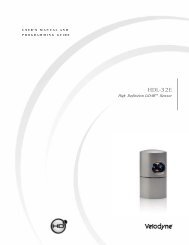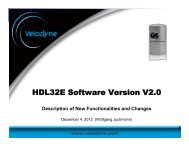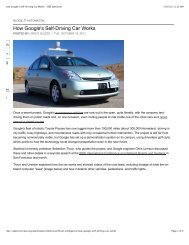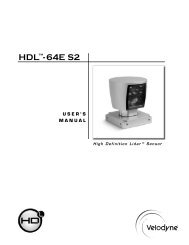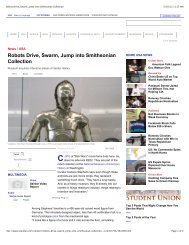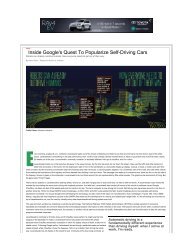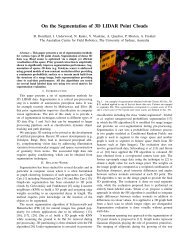HDLâ¢- 64E - Velodyne Lidar
HDLâ¢- 64E - Velodyne Lidar
HDLâ¢- 64E - Velodyne Lidar
You also want an ePaper? Increase the reach of your titles
YUMPU automatically turns print PDFs into web optimized ePapers that Google loves.
Since the area of the detector is smaller than the laser spot sizes, a Detector Correction<br />
Factor for this aperture will be used. This Detector Correction Factor is:<br />
Case a) 38.465 / 720 = 0.0534<br />
Case b) 38.465 / 731 = 0.0526<br />
Case c) 38.465 / 507.2 = 0.0758<br />
Case d) 38.465 / 124.8 = 0.3082<br />
Per IEC 60285, for a repetitively pulsed laser source, three conditions must be checked to<br />
validate the Product Laser Classification. The Product shall be Classified as the worst case<br />
rating of these three conditions.<br />
Condition 1: Single Pulse Accessible Emission Limit<br />
The formula for calculating the detected single pulse energy is:<br />
[Peak Power] * [Pulse Width] * [Number of Lasers Overlapping] * [Detector Correction<br />
Factor]<br />
Case a: Detected Laser Energy SP = 60 [W] * 5 [ns] * 2 * .0534 = 32.0 nJ<br />
Case b: Detected Laser Energy SP = 60 [W] * 5 [ns] * 2 * .0526 = 31.6 nJ<br />
Case c: Detected Laser Energy SP = 60 [W] * 5 [ns] * 1 * .0758 = 22.7 nJ<br />
Case d: Detected Laser Energy SP = 60 [W] * 5 [ns] * 1 * .3082 = 92.5 nJ<br />
The single pulse AEL is calculated from Table 4 of IEC 60285-1,<br />
Class 1M AEL SP = 2 * 10 -7 * C 4<br />
Where C 4 is derived from Table 10:<br />
0.002*( _- 700)<br />
C 4 = 10<br />
Where _ = 905 [nm]<br />
C 4 = 2.57<br />
Class 1M AEL SP = 514 nJ<br />
Condition 1 Conclusion<br />
Since all Cases are lower than the Class 1M AEL SP , the Product is rated as Class 1M for this<br />
Condition.<br />
Condition 2: Average Accessible Emission Limit (1 second exposure)<br />
The average power is calculated similarly to Condition 1, except more lasers overlap in the<br />
Pulse Repetition period. The formula for calculating the fixed position power is:<br />
[Detected Laser Energy SP ] * [Pulse Repetition Rate] * [Laser Overlap] * [Head Overlap] *<br />
[Sequential Duty Cycle] * [Rotation Factor]<br />
where the Laser Overlap is the number of times within the Base Repetition Period a<br />
laser emission illuminates the detector. In Cases a and b, there are 8 separate<br />
laser emissions that overlap the same spot size (all lasers within the burst<br />
period overlap). In Case c, this number is 3 to account for the maximum<br />
overlap within the head as the unit rotates. In Case d, there is no overlap, so<br />
this number is 1.<br />
the Head Overlap is the number of Heads that will cross the fixed position detector in<br />
a single rotation. In Cases a, b and c, this number is 2. In Case d, there is no<br />
overlap of left and right heads, so this number is 1.<br />
the Sequential Duty Cycle is how often the Upper Head of the Product is triggered in<br />
the system operation. This number is 0.75.<br />
- 14 -




